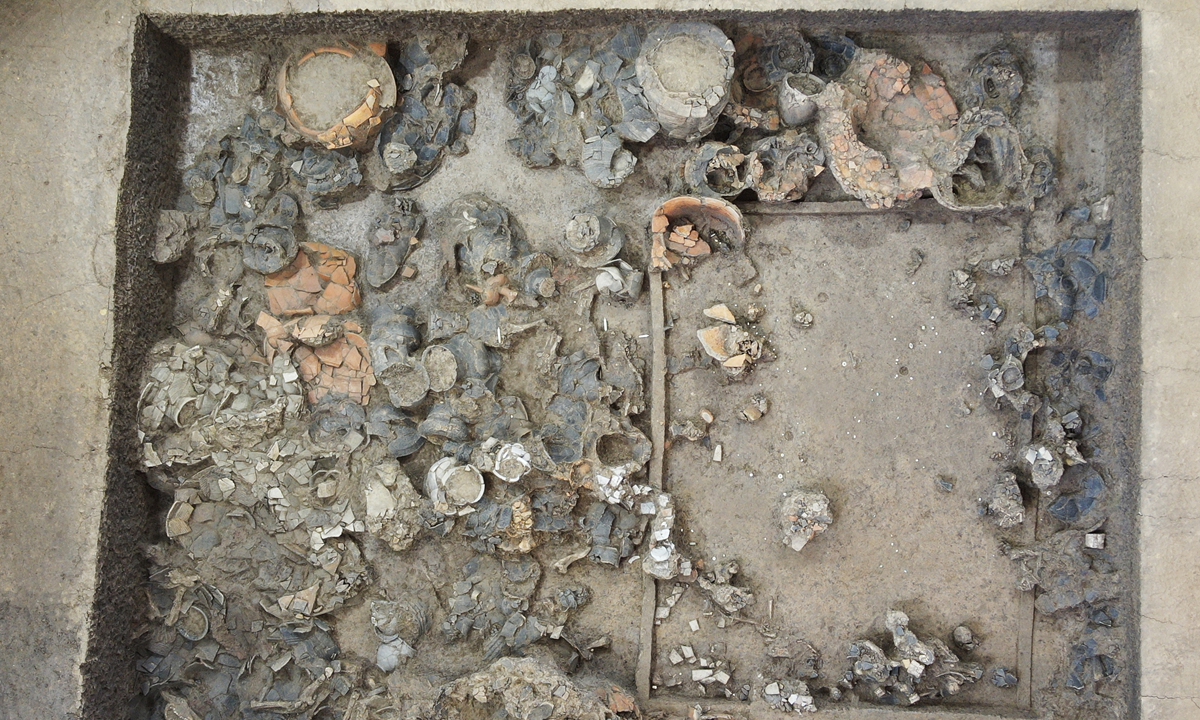
The excavation site of the M27 tomb at the Wangzhuang site in Central China's Henan Province Photo: Courtesy of Zhu Guanghua
A large tomb dating back approximately 5,000 years was discovered at the Wangzhuang ruins in the city of Yongcheng, Central China's Henan Province, providing a new sample for studying the critical period of the origins of Chinese civilization, Chinese archaeologists told the Global Times on Tuesday.
The tomb has yielded over 350 artifacts, including hundreds of jade and pottery pieces, pig jawbones symbolizing wealth, and intricately decorated ivory ornaments, making it one of the largest and most artifact-rich tombs found from the Dawenkou culture period (4000 BC-2600 BC), a culture of the late Neolithic Age, Xinhua News Agency reported on Monday.
The newly discovered M27 is a particularly large Dawenkou culture tomb with an area of over 17 square meters. The scale of the tomb suggests that the occupant held a prominent position, leading experts to speculate that it may have belonged to the monarch of an ancient state.
Zhu Guanghua, an associate professor at Capital Normal University who participated in the archaeological excavation, told the Global Times on Tuesday that it is the largest tomb in the Dawenkou period.
"It is interesting to note that the tomb was intentionally damaged by ancient enemy forces. Only a small number of human bones were found in the tomb, with no complete human skeleton discovered," he said.
"This discovery provides new evidence for the development trace in ancient kingdoms across various regions during the formation period of Chinese civilization around 5,000 years ago," Li Xinwei, deputy director of the Institute of Archaeology at the Chinese Academy of Social Sciences, told the Global Times on Tuesday.
The media reported that the Wangzhuang site is a large settlement in the middle to late Dawenkou culture period. Since 2023, a joint archaeological team has been conducting archaeological excavations at the site.
Liu Haiwang, head of the archaeological team, told the Xinhua News Agency that in 2024, 45 Dawenkou culture tombs were newly discovered at the Wangzhuang site, and 27 of them have already been excavated. Some of these tombs appear to belong to high-ranking officials, presenting a number of valuable artifacts and pig jawbones representing wealth.
Among them, the M27 tomb measures about 4.8 meters in length and 3.68 meters in width. The tomb chamber, containing both an inner and an outer coffin, is very rich in burial objects, including various types of pottery and over 300 jade ornaments.
Liu said that the high-ranking tombs yielded stone ceremonial tablets and jade axes with strong ritual connotations, which had a profound influence on the ritual culture of the Xia, Shang, and Zhou dynasties and later periods. Notably, the discovery of this tomb highlights the initial form of imperial power in the prehistoric Central Plains.
So far, the Wangzhuang site has yielded over 1,000 artifacts. Based on the shapes of the findings, the cultural characteristics of the site are complex, with the main remains belonging to the Dawenkou culture, but also incorporating elements from the Yangshao and Liangzhu cultures.
"The Wangzhuang site is a melting pot of multicultural exchanges, influenced by the cultures of China's eastern region and central region as well as the Yangtze River basin, while developing its own unique features," said Li, adding that the discovery offers an important specimen for the study of the integration of different regional cultures in prehistoric times.
Currently, the excavation of the site is still underway. Zhu said the cultural relics unearthed from the tomb have now been cleaned up, and the next step will be to extract them for more detailed research.




